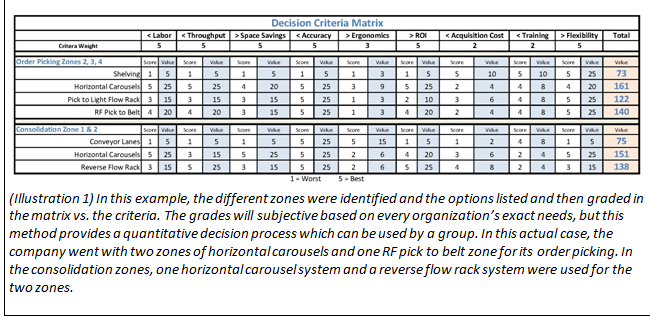Are companies ready to take advantage of a potential growth opportunity in order to meet customer demand? Coupled with this question is the concern that without added operational efficiencies, will our US-based companies be able to compete with overseas companies who are capable of providing lower costs?
The slow but steady growth forecast is a window of opportunity that offers companies the time to develop and execute plans in order to improve efficiencies. Improving efficiencies allow organizations to not only prosper, but to improve customer satisfaction levels by providing the optimum customer experience. Today, that means offering same day or next day delivery, free shipping, hassle free returns, and always “in stock” inventory.
An optimum means of reducing costs to help pay for these services is through cost-effective order picking and fulfillment operations. Consider that in warehouse and distribution center operations, storing and distributing goods are non-value added functions, and the cost of order picking is estimated to be as much as 55% of the total warehouse operating expense. The cost of these functions can be reduced by streamlining manpower requirements, minimizing inventory and by increasing throughput. In effect, doing more with less.
The cost of your warehouse picking, packing, sorting and shipping operations can be dramatically reduced over time by utilizing technology. Utilizing technology allows an organization to reduce its labor, floor space and inventory levels while increasing accuracy and extending order cut-off times.
Let’s start by breaking down your facility into specific functions. Bulk storage, order picking, order packing, shipping are generally good places to start. Next, consider simple technologies to begin with such as pick to light, carousels, vertical lift modules (VLMs) software, weigh scales and manifest and document printers, just to name a few. But the question still remains, “What type of system or equipment is best for my operations and business?” This is where using a decision matrix becomes important.
Where to Start?
The choices may appear confusing and overwhelming at first. However, by creating a decision criteria matrix, you can analytically measure and evaluate your options to be assured of making the right decisions.
A decision matrix is a list of values in rows and columns that help identify, analyze, and rate the performance of relationships between sets of values and information. Options are scored and totaled to gain a score that can be ranked. The matrix will help you zero in on a system, or combination of systems, that can significantly reduce costs, improve efficiency and influence bottom line profitability.
The critical consideration is to utilize the type of equipment and systems that meets your facility’s specific needs and objectives.
As an initial step in creating a decision matrix, do some homework. Determine the strengths of your company and also areas where your company may need to improve. Is your company known for innovative product design, just-in-time manufacturing, on-time delivery, or fast order turnaround? In what areas would your company like to improve? Better throughput, more efficient operation, faster deliveries, or fewer returns?
What are the marketplace challenges facing your company? What is your company’s market share? Who is your competition and how do they differ from your company? Is the market open to more competition?
Define your customer base. Who are your potential customers? What makes them prospects? Who are your customers and what types of businesses do they provide? What are your customers’ expectations? How do your customers expect to receive products, and in what initial time frame?
The way to gather this information is to interview your own management, particularly marketing and sales staff. Their input, along with input from executive management, will help you build a model of your company’s relationship with its customers. Visit your customers’ websites to get a sense of how they position themselves to their customers. Also, visit the websites of trade publications that cover your markets to learn about market trends. Armed with all of this valuable information, you can create a statement that answers the question, “Is there a better way to deliver my product, and meet my company’s business objectives?”
Now is the time to prepare the actual decision matrix by first identifying criteria that are important to meeting order fulfillment goals and business objectives such as scalability, system flexibility, improved productivity, increased throughput, improved accuracy, fast installation, floor space savings, ergonomics, meeting green and/or lean initiatives. Evaluate these criteria vs. qualitative factors such as not important, important, very important, and must haves.
Examine and Evaluate
Examine and evaluate a variety of materials handling and logistics management systems to determine if they meet system criteria. List the types of order picking systems and equipment on the left hand side, or vertical axis, of the matrix. Across the top of the grid, list the selection criteria. The criteria should be “things” that are important to your operations and overall success of the operation.
For example, if a primary concern is running out of space, then floor space requirements would be top criteria. Reducing labor, improving worker ergonomics, sustainability, reduced training, future flexibility/growth, ability to repurpose the equipment, longevity and speed of implementation… well the list can go on and on.
List everything by importance.
While working on this, if additional criteria comes to the surface, no problem. Add it, and simply evaluate the equipment and technologies you have already completed. This is a flexible methodology and tool designed to help build decisions and validate answers.
Once your grid is complete, use a scale from 1 to 5, and rate each system based on how well it meets that specific criteria. Total the ratings. The systems with the highest totals may be the systems that can best meet your organization’s order picking and fulfillment needs. If there are some criteria which are more important than others, you can also give a 1 to 5 weight for each criterion. This makes one criteria “more important” than another.
The slow but steady growth forecast is a window of opportunity that offers companies the time to develop and execute plans in order to improve efficiencies. Improving efficiencies allow organizations to not only prosper, but to improve customer satisfaction levels by providing the optimum customer experience. Today, that means offering same day or next day delivery, free shipping, hassle free returns, and always “in stock” inventory.
An optimum means of reducing costs to help pay for these services is through cost-effective order picking and fulfillment operations. Consider that in warehouse and distribution center operations, storing and distributing goods are non-value added functions, and the cost of order picking is estimated to be as much as 55% of the total warehouse operating expense. The cost of these functions can be reduced by streamlining manpower requirements, minimizing inventory and by increasing throughput. In effect, doing more with less.
The cost of your warehouse picking, packing, sorting and shipping operations can be dramatically reduced over time by utilizing technology. Utilizing technology allows an organization to reduce its labor, floor space and inventory levels while increasing accuracy and extending order cut-off times.
Let’s start by breaking down your facility into specific functions. Bulk storage, order picking, order packing, shipping are generally good places to start. Next, consider simple technologies to begin with such as pick to light, carousels, vertical lift modules (VLMs) software, weigh scales and manifest and document printers, just to name a few. But the question still remains, “What type of system or equipment is best for my operations and business?” This is where using a decision matrix becomes important.
Where to Start?
The choices may appear confusing and overwhelming at first. However, by creating a decision criteria matrix, you can analytically measure and evaluate your options to be assured of making the right decisions.
A decision matrix is a list of values in rows and columns that help identify, analyze, and rate the performance of relationships between sets of values and information. Options are scored and totaled to gain a score that can be ranked. The matrix will help you zero in on a system, or combination of systems, that can significantly reduce costs, improve efficiency and influence bottom line profitability.
The critical consideration is to utilize the type of equipment and systems that meets your facility’s specific needs and objectives.
As an initial step in creating a decision matrix, do some homework. Determine the strengths of your company and also areas where your company may need to improve. Is your company known for innovative product design, just-in-time manufacturing, on-time delivery, or fast order turnaround? In what areas would your company like to improve? Better throughput, more efficient operation, faster deliveries, or fewer returns?
What are the marketplace challenges facing your company? What is your company’s market share? Who is your competition and how do they differ from your company? Is the market open to more competition?
Define your customer base. Who are your potential customers? What makes them prospects? Who are your customers and what types of businesses do they provide? What are your customers’ expectations? How do your customers expect to receive products, and in what initial time frame?
The way to gather this information is to interview your own management, particularly marketing and sales staff. Their input, along with input from executive management, will help you build a model of your company’s relationship with its customers. Visit your customers’ websites to get a sense of how they position themselves to their customers. Also, visit the websites of trade publications that cover your markets to learn about market trends. Armed with all of this valuable information, you can create a statement that answers the question, “Is there a better way to deliver my product, and meet my company’s business objectives?”
Now is the time to prepare the actual decision matrix by first identifying criteria that are important to meeting order fulfillment goals and business objectives such as scalability, system flexibility, improved productivity, increased throughput, improved accuracy, fast installation, floor space savings, ergonomics, meeting green and/or lean initiatives. Evaluate these criteria vs. qualitative factors such as not important, important, very important, and must haves.
Examine and Evaluate
Examine and evaluate a variety of materials handling and logistics management systems to determine if they meet system criteria. List the types of order picking systems and equipment on the left hand side, or vertical axis, of the matrix. Across the top of the grid, list the selection criteria. The criteria should be “things” that are important to your operations and overall success of the operation.
For example, if a primary concern is running out of space, then floor space requirements would be top criteria. Reducing labor, improving worker ergonomics, sustainability, reduced training, future flexibility/growth, ability to repurpose the equipment, longevity and speed of implementation… well the list can go on and on.
List everything by importance.
While working on this, if additional criteria comes to the surface, no problem. Add it, and simply evaluate the equipment and technologies you have already completed. This is a flexible methodology and tool designed to help build decisions and validate answers.
Once your grid is complete, use a scale from 1 to 5, and rate each system based on how well it meets that specific criteria. Total the ratings. The systems with the highest totals may be the systems that can best meet your organization’s order picking and fulfillment needs. If there are some criteria which are more important than others, you can also give a 1 to 5 weight for each criterion. This makes one criteria “more important” than another.

Let's Look at an Example
To see how the criteria matrix works in action, let’s review an actual matrix done by a leading beauty products distributor (illustration 1). They were concerned that their current manual order picking systems and processes would not allow the company to effectively compete against their growing competition. Company management determined that selection criteria needed to improve employee productivity, increased picking throughput, high accuracy levels, improved ergonomics, and space savings were the primary objectives in determining the right system. They grouped: improved productivity, increased throughput and high accuracy as “must have” features with improved ergonomics and space savings as “important.”
To see how the criteria matrix works in action, let’s review an actual matrix done by a leading beauty products distributor (illustration 1). They were concerned that their current manual order picking systems and processes would not allow the company to effectively compete against their growing competition. Company management determined that selection criteria needed to improve employee productivity, increased picking throughput, high accuracy levels, improved ergonomics, and space savings were the primary objectives in determining the right system. They grouped: improved productivity, increased throughput and high accuracy as “must have” features with improved ergonomics and space savings as “important.”
In building the decision matrix, the company listed various types of equipment and systems down the left hand side of the grid. Included in their list were vertical carousels, Vertical Lift Modules (VLMs), horizontal carousels, pick-to-light system, pick modules, RFID picking zones, consolidation zones, and conveyor system. Across the top of the grid, they listed the selection criteria. Using a 1 to 5 scale, they assigned values to each device. Those devices that received the highest totals were horizontal carousels, RFID pick zones and consolidation zones.
The process is almost complete. There is, however, an important final step.
Proving System Viability
Once you have selected a system, it’s good practice to get a rough idea if it is realistically possible for your organization to economically utilize this system. There are three major variables that influence price: throughput, space and budget.
Once you have selected a system, it’s good practice to get a rough idea if it is realistically possible for your organization to economically utilize this system. There are three major variables that influence price: throughput, space and budget.
Each factor has a direct influence on the other. As the system purchaser, you can usually control two out of the three points. The best advice is to evaluate the three-choice approach to see if the type of system you have in mind will work for your organization. This process will help you refine the parameters of your choice and select the system that fits your real world situation.
Return on Investment
In all cases, it’s a must-do to compare the efficiency and operating costs of any materials handling process improvement project and determine their ROI/IRR (Return on Investment/Internal Rate of Return). This should always be one of your primary criteria. General accounting practices say any investment with an internal rate of return over five provides immediate value back to the organization.
Return on Investment
In all cases, it’s a must-do to compare the efficiency and operating costs of any materials handling process improvement project and determine their ROI/IRR (Return on Investment/Internal Rate of Return). This should always be one of your primary criteria. General accounting practices say any investment with an internal rate of return over five provides immediate value back to the organization.
ROI Considerations:
• Amount of floor space occupied by current equipment
• Cost per square foot
• Number of employees handling transactions
• Number of daily transactions
• Average labor costs
• Value added opportunities. With the space and labor you save what revenue generating activities will be created.
• Amount of floor space occupied by current equipment
• Cost per square foot
• Number of employees handling transactions
• Number of daily transactions
• Average labor costs
• Value added opportunities. With the space and labor you save what revenue generating activities will be created.
Rigorous ROI/IRR analysis can financially “prove in” your system choice, assuring you that you have made the correct system selection to improve materials flow and meet business objectives.
Improving materials handling processes is one of the fastest ways to reach these objectives. The resulting improvements in the throughput, productivity, accuracy, and general efficiency of any materials handling and order picking and fulfillment operation have a direct effect on your organization’s bottom line, as well as your organization’s market share.
As always, business is about selling, competition and market share, but today, these factors are even more challenging in a shifting global economy. By building and examining your direct matrix analysis, materials handling process improvement offers a valuable solution to reducing operating costs while enhancing quality and customer service.
Ed Romaine is the CMO-VP Marketing for Integrated Systems Design - ISD, which provides consulting and integration of cost effective automated order picking, packing and shipping systems for warehouses, distribution centers and manufacturers. He can be reached at edromaine@isddd.com or 215-431-4524 . Visit www.ISDDD.com or https://plus.google.com/+EdRomaine.











